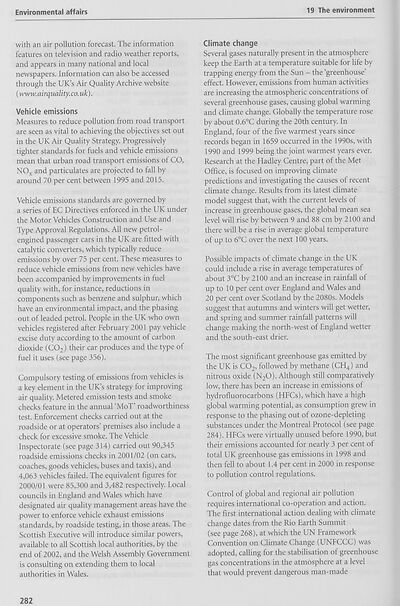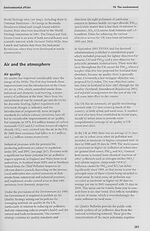Download files
Complete book:
Individual page:
Thumbnail gallery: Grid view | List view

Environmental affairs
19 The environment
with an air pollution forecast. The information
features on television and radio weather reports,
and appears in many national and local
newspapers. Information can also be accessed
through the UK’s Air Quality Archive website
(www.airquality.co.uk).
Vehicle emissions
Measures to reduce pollution from road transport
are seen as vital to achieving the objectives set out
in the UK Air Quality Strategy. Progressively
tighter standards for fuels and vehicle emissions
mean that urban road transport emissions of CO,
NOx and particulates are projected to fall by
around 70 per cent between 1995 and 2015.
Vehicle emissions standards are governed by
a series of EC Directives enforced in the UK under
the Motor Vehicles Construction and Use and
Type Approval Regulations. All new petrol-
engined passenger cars in the UK are fitted with
catalytic converters, which typically reduce
emissions by over 75 per cent. These measures to
reduce vehicle emissions from new vehicles have
been accompanied by improvements in fuel
quality with, for instance, reductions in
components such as benzene and sulphur, which
have an environmental impact, and the phasing
out of leaded petrol. People in the UK who own
vehicles registered after February 2001 pay vehicle
excise duty according to the amount of carbon
dioxide (C02) their car produces and the type of
fuel it uses (see page 356).
Compulsory testing of emissions from vehicles is
a key element in the UK’s strategy for improving
air quality. Metered emission tests and smoke
checks feature in the annual ‘MoT’ roadworthiness
test. Enforcement checks carried out at the
roadside or at operators’ premises also include a
check for excessive smoke. The Vehicle
Inspectorate (see page 314) carried out 90,345
roadside emissions checks in 2001/02 (on cars,
coaches, goods vehicles, buses and taxis), and
4,063 vehicles failed. The equivalent figures for
2000/01 were 85,300 and 3,482 respectively. Local
councils in England and Wales which have
designated air quality management areas have the
power to enforce vehicle exhaust emissions
standards, by roadside testing, in those areas. The
Scottish Executive will introduce similar powers,
available to all Scottish local authorities, by the
end of 2002, and the Welsh Assembly Government
is consulting on extending them to local
authorities in Wales.
Climate change
Several gases naturally present in the atmosphere
keep the Earth at a temperature suitable for life by
trapping energy from the Sun - the greenhouse’
effect. However, emissions from human activities
are increasing the atmospheric concentrations of
several greenhouse gases, causing global warming
and climate change. Globally the temperature rose
by about 0.6°C during the 20th century. In
England, four of the five warmest years since
records began in 1659 occurred in the 1990s, with
1990 and 1999 being the joint warmest years ever.
Research at the Hadley Centre, part of the Met
Office, is focused on improving climate
predictions and investigating the causes of recent
climate change. Results from its latest climate
model suggest that, with the current levels of
increase in greenhouse gases, the global mean sea
level will rise by between 9 and 88 cm by 2100 and
there will be a rise in average global temperature
of up to 6°C over the next 100 years.
Possible impacts of climate change in the UK
could include a rise in average temperatures of
about 3°C by 2100 and an increase in rainfall of
up to 10 per cent over England and Wales and
20 per cent over Scotland by the 2080s. Models
suggest that autumns and winters will get wetter,
and spring and summer rainfall patterns will
change making the north-west of England wetter
and the south-east drier.
The most significant greenhouse gas emitted by
the UK is C02, followed by methane (CH4) and
nitrous oxide (N20). Although still comparatively
low, there has been an increase in emissions of
hydrofluorocarbons (HFCs), which have a high
global warming potential, as consumption grew in
response to the phasing out of ozone-depleting
substances under the Montreal Protocol (see page
284). HFCs were virtually unused before 1990, but
their emissions accounted for nearly 3 per cent of
total UK greenhouse gas emissions in 1998 and
then fell to about 1.4 per cent in 2000 in response
to pollution control regulations.
Control of global and regional air pollution
requires international co-operation and action.
The first international action dealing with climate
change dates from the Rio Earth Summit
(see page 268), at which the UN Framework
Convention on Climate Change (UNFCCC) was
adopted, calling for the stabilisation of greenhouse
gas concentrations in the atmosphere at a level
that would prevent dangerous man-made
282
19 The environment
with an air pollution forecast. The information
features on television and radio weather reports,
and appears in many national and local
newspapers. Information can also be accessed
through the UK’s Air Quality Archive website
(www.airquality.co.uk).
Vehicle emissions
Measures to reduce pollution from road transport
are seen as vital to achieving the objectives set out
in the UK Air Quality Strategy. Progressively
tighter standards for fuels and vehicle emissions
mean that urban road transport emissions of CO,
NOx and particulates are projected to fall by
around 70 per cent between 1995 and 2015.
Vehicle emissions standards are governed by
a series of EC Directives enforced in the UK under
the Motor Vehicles Construction and Use and
Type Approval Regulations. All new petrol-
engined passenger cars in the UK are fitted with
catalytic converters, which typically reduce
emissions by over 75 per cent. These measures to
reduce vehicle emissions from new vehicles have
been accompanied by improvements in fuel
quality with, for instance, reductions in
components such as benzene and sulphur, which
have an environmental impact, and the phasing
out of leaded petrol. People in the UK who own
vehicles registered after February 2001 pay vehicle
excise duty according to the amount of carbon
dioxide (C02) their car produces and the type of
fuel it uses (see page 356).
Compulsory testing of emissions from vehicles is
a key element in the UK’s strategy for improving
air quality. Metered emission tests and smoke
checks feature in the annual ‘MoT’ roadworthiness
test. Enforcement checks carried out at the
roadside or at operators’ premises also include a
check for excessive smoke. The Vehicle
Inspectorate (see page 314) carried out 90,345
roadside emissions checks in 2001/02 (on cars,
coaches, goods vehicles, buses and taxis), and
4,063 vehicles failed. The equivalent figures for
2000/01 were 85,300 and 3,482 respectively. Local
councils in England and Wales which have
designated air quality management areas have the
power to enforce vehicle exhaust emissions
standards, by roadside testing, in those areas. The
Scottish Executive will introduce similar powers,
available to all Scottish local authorities, by the
end of 2002, and the Welsh Assembly Government
is consulting on extending them to local
authorities in Wales.
Climate change
Several gases naturally present in the atmosphere
keep the Earth at a temperature suitable for life by
trapping energy from the Sun - the greenhouse’
effect. However, emissions from human activities
are increasing the atmospheric concentrations of
several greenhouse gases, causing global warming
and climate change. Globally the temperature rose
by about 0.6°C during the 20th century. In
England, four of the five warmest years since
records began in 1659 occurred in the 1990s, with
1990 and 1999 being the joint warmest years ever.
Research at the Hadley Centre, part of the Met
Office, is focused on improving climate
predictions and investigating the causes of recent
climate change. Results from its latest climate
model suggest that, with the current levels of
increase in greenhouse gases, the global mean sea
level will rise by between 9 and 88 cm by 2100 and
there will be a rise in average global temperature
of up to 6°C over the next 100 years.
Possible impacts of climate change in the UK
could include a rise in average temperatures of
about 3°C by 2100 and an increase in rainfall of
up to 10 per cent over England and Wales and
20 per cent over Scotland by the 2080s. Models
suggest that autumns and winters will get wetter,
and spring and summer rainfall patterns will
change making the north-west of England wetter
and the south-east drier.
The most significant greenhouse gas emitted by
the UK is C02, followed by methane (CH4) and
nitrous oxide (N20). Although still comparatively
low, there has been an increase in emissions of
hydrofluorocarbons (HFCs), which have a high
global warming potential, as consumption grew in
response to the phasing out of ozone-depleting
substances under the Montreal Protocol (see page
284). HFCs were virtually unused before 1990, but
their emissions accounted for nearly 3 per cent of
total UK greenhouse gas emissions in 1998 and
then fell to about 1.4 per cent in 2000 in response
to pollution control regulations.
Control of global and regional air pollution
requires international co-operation and action.
The first international action dealing with climate
change dates from the Rio Earth Summit
(see page 268), at which the UN Framework
Convention on Climate Change (UNFCCC) was
adopted, calling for the stabilisation of greenhouse
gas concentrations in the atmosphere at a level
that would prevent dangerous man-made
282
Set display mode to:
![]() Universal Viewer |
Universal Viewer | ![]() Mirador |
Large image | Transcription
Mirador |
Large image | Transcription
The item on this page appears courtesy of Office for National Statistics and may be re-used under the Open Government Licence for Public Sector Information.
| Britain and UK handbooks > UK: The official yearbook of the United Kingdom of Great Britain and Northern Ireland > 2003 > (316) |
|---|
| Permanent URL | https://digital.nls.uk/204927218 |
|---|
| Attribution and copyright: |
|
|---|---|
| Description | Three volumes of 'UK: The official yearbook of the United Kingdom of Great Britain and Northern Ireland', published annually by the Office of National Statistics from 2002-2005. |
|---|---|
| Shelfmark | GII.11 SER |
| Description | Three titles produced by the British Government from 1954-2005 describing 'how Britain worked'. They are: 'Britain: An official handbook' (1954-1998), 'Britain: The official yearbook of the United Kingdom' (1999-2001), and 'UK: The official yearbook of the United Kingdom of Great Britain and Northern Ireland' (2002-2005). These 50 reports provide an overview of Britain's economic, social and cultural affairs, its environment, international relations, and the systems of government. They give an impartial summary of government policies and initiatives, and explain how public services are organised. |
|---|---|
| Additional NLS resources: |
|

